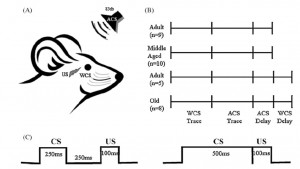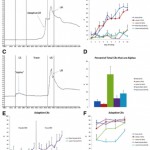Behavior

From Galvez et al. 2009. Fig. 1. Schematic diagram of a paradigm assessing associative learning in response to whisker-stimulation in mice at three different ages.
Our laboratory focuses on characterizing the mechanisms by which neuronal networks and individual neurons process and store new information during and after learning. Eyeblink conditioning is our primary model paradigm to assess associative learning. This Pavlovian task offers excellent stimulus control, ease of precise behavioral measurement, robust associative learning, and can be used to test both human and non-human animal subjects.
We use rabbits , rats, mice, or humans depending upon the question being asked. We also use a broad set of additional techniques, including fear conditioning, spatial navigation in the Morris water maze and others, to assess other types of behavior to evaluate the specificity of experimental manipulations on mechanisms of associative learning. An important focus of our research is on network and cellular mechanisms that are altered by aging or neurodegenerative diseases such as Alzheimer’s Disease. For more information about the full behavioral repertoire of behavioral tests employed, please visit the Behavioral Phenotyping Core.

From Flores and Disterhoft 2009. Fig. 1. Bilateral lesions of the caudate nucleus prevent adaptive CRs during trace EBC and increase the proportion of nonadaptive alpha blinks.
Representative publications:
- Lin C, Disterhoft J, Weiss C (2016) Whisker-signaled Eyeblink Classical Conditioning in Head-fixed Mice. J Vis Exp 109:e54410
- Curlik DM, Weiss C, Nicholson DA, Disterhoft JF (2014) Age-related impairments on one hippocampal-dependent task predict impairments on a subsequent hippocampal-dependent task. Behav. Neurosci. 128(6):676-88.
- Suter EE, Weiss C, Disterhoft (2013) Perirhinal and postrhinal, but not lateral entorhinal, cortices are essential for acquisition of trace eyeblink conditioning. Learn. Mem. 20(2):80-4.
- Galvez R, Cua S, Disterhoft JF (2009) Age-related deficits in a forebrain-dependent task, trace-eyeblink conditioning. Neurobiol Aging 32(10):1915-22.
- Flores LC and Disterhoft JF (2009) Caudate nucleus is critically involved in trace eyeblink conditioning. J Neurosci 29(46): 14511-14520.
